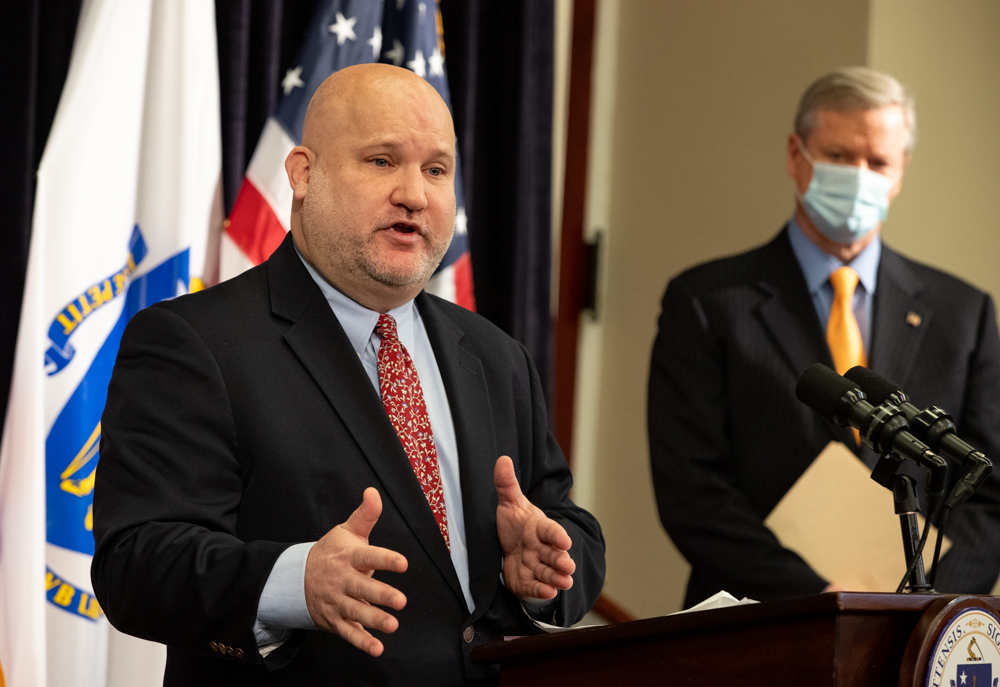Massachusetts schools this week will be able to sign up to receive at-home rapid COVID-19 tests for weekly use by their students and staff, and those that choose to do so will stop contact tracing and participating in the “test-and-stay” program that allows close contacts to stay in the classroom as long as they test negative for the virus daily.
State officials said Tuesday the new option for local school districts will allow school nurses to focus more on symptomatic individuals and general COVID-19 management. Schools will still need to continue participating in symptomatic or pooled testing to take part in the new at-home test program.
K-12 students and staff at schools that opt in to the program will receive one packet of two COVID tests each week for use on a day designated by local officials. Local districts can start opting in to the program for staff this week and will start receiving tests for staff during the week of Jan. 24 while tests for students will be distributed the week of Jan. 31.
The tests will be shipped directly to school districts and come from a supply of 26 million rapid tests that Gov. Charlie Baker announced last week his administration had ordered from iHealth.
“School nurses and others have done an incredible job around the clock to make [the test-and-stay] program operate as effectively as it has here in Massachusetts and it’s been massively successful in avoiding days lost at home,” Baker said on Tuesday. “But the current state of the pandemic requires that we adapt our efforts to meet the times.”
The Department of Elementary and Secondary Education said the move would “enable school health staff to spend more time and resources identifying symptomatic individuals and focusing on other aspects of COVID-19 management.”
DESE Commissioner Jeff Riley called the new at-home testing program a “game changer,” adding the new program allows schools to pivot strategies away from identifying asymptomatic close contacts to COVID mitigation and symptomatic testing efforts.
“We’ve also heard from many nurses and school administrators urging us to make changes to our test-and-stay program and the contact tracing associated with it,” Riley said. “And both our medical advisors and the [Department of Public Health] say it’s time to pivot.”
During the week of Jan. 6 to Jan. 12, school districts reported 41,063 new COVID-19 cases among students and 7,351 in staff members. Despite elevated caseloads, state education officials estimated individual positivity rates among students and staff were still roughly one-fifth of the statewide positivity rate.
In a Tuesday letter from Riley to local school officials, the commissioner said positivity rates from the test-and-stay program indicate that individuals identified as close contacts in school are “very unlikely” to contract or spread COVID-19.
“These data show that transmission from close contacts is a rare occurrence in schools and that, therefore, extensive contact tracing and associated Test and Stay procedures are not adding significant value as a mitigation strategy despite the demand they place on the time of school health staff and school staff at large,” the letter said. “As a result, we are recommending that school health personnel increase their focus on identifying symptomatic individuals, rather than monitoring in-school close contacts who are unlikely to contract or spread the virus.”
The new testing option, the letter said, will “uniquely support” the shift in focus, and will also shift some testing responsibilities away from schools and towards parents and students.
Schools will ask parents to sign a permission form and watch an informational video with directions on administering the at-home tests. If an individual tests positive, school officials are asking staff or parents to commit to calling their school and informing them of the positive test results.
Schools will then report positive cases to DESE as part of the department’s weekly COVID-19 reporting that is already in place.
The test-and-stay program allows teachers and students who are identified as close contacts to a COVID-19 case to stay in classrooms so long as they continue to test negative for the virus on a daily basis.
State education and Baker administration officials argued the program helped prevent disruptions to in-person learning for students. Riley said Tuesday that the test-and-stay program was conceived and launched before school-aged children were eligible for a vaccine.
“We need to pivot from strategies that worked in the fall to policies that are more aligned with how things have changed,” Riley said. “… This is something that is just better for our kids and gives more coverage, and at the same time provides [health staff] more relief so they can focus on symptomatic cases.”
Baker said the new at-home testing program is “just the latest way that we think we can keep kids in school.”
“And while testing is an important tool, I would like to remind everyone, once again, that getting vaccinated is the best thing you can do to protect yourself, our educators and our kids,” Baker said. “If you haven’t been vaccinated or boosted, please book an appointment.”
